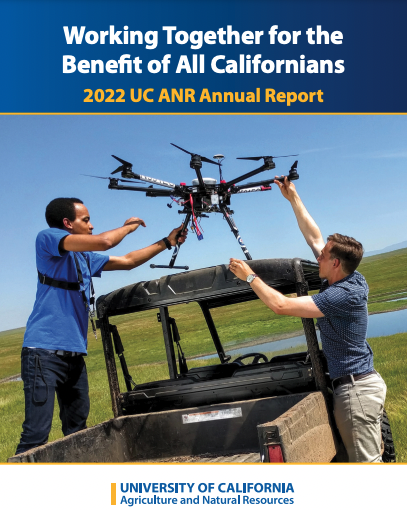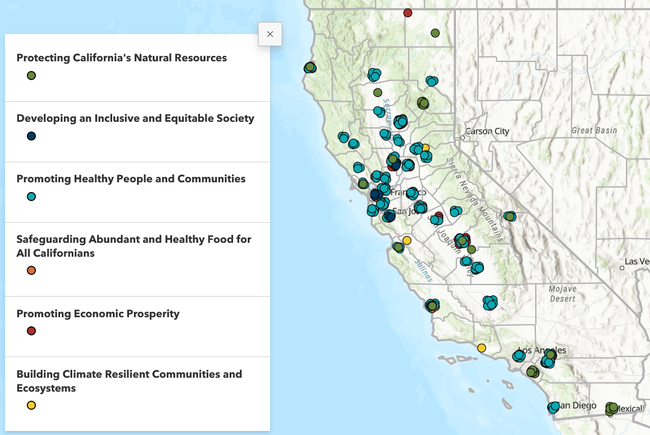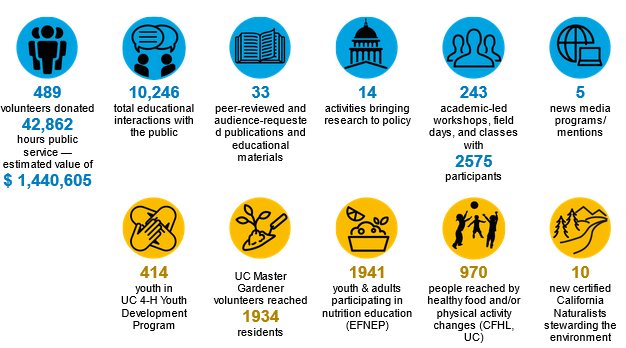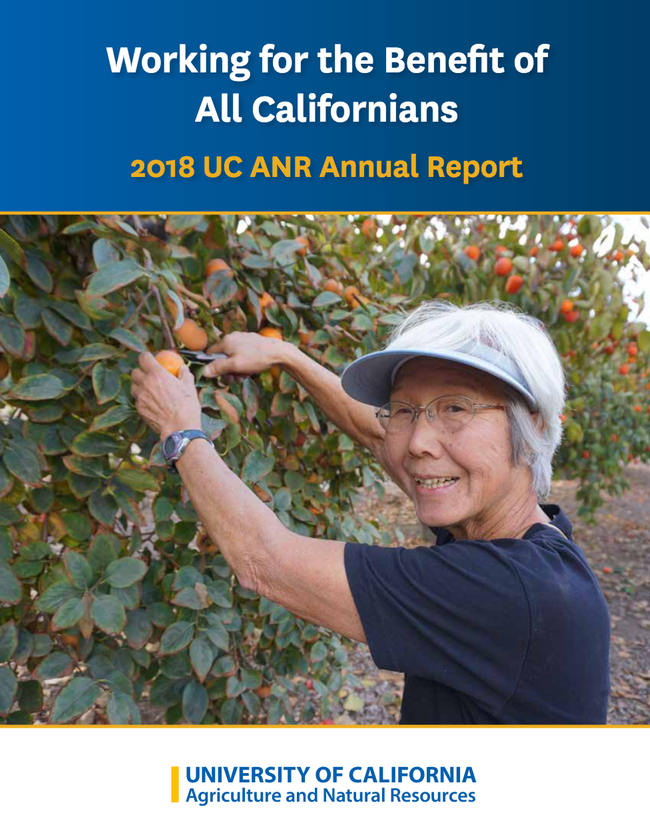Posts Tagged: Program Planning and Evaluation
The UC ANR 2022 Annual Report is online
UC ANR's 2022 Annual Report is now live. The report highlights Agricultural Experiment Station and Cooperative Extension projects that clearly contribute to UC ANR condition changes and public values, demonstrating the organization's vision to improve the lives of all 39 million residents in California.
“Kudos to all for giving us these impact stories,” Vice President Glenda Humiston said. “These are what capture stakeholders, lay audiences, legislators and policymakers at all levels. They want to know what's in it for them.”
The Program Planning and Evaluation unit collaborated with UC ANR academics, program staff, and Strategic Communications to compile more than 50 vignettes that highlight the impact of our organization statewide during 2022.
Feel free to publicize our efforts and impact by sharing the annual report via email or social media with friends, the public, policymakers and potential donors. The annual report is posted online on the UC ANR "About" page and the direct link is https://ucanr.edu/2022annualreport. A few printed copies of the annual report are available.
If you have any questions about the annual report, please contact Christina Becker at christina.becker@ucop.edu.
New interactive map tool shows UC ANR’s impact
The UC ANR Impact StoryMap highlights measured changes in conditions resulting from programmatic efforts and serves as evidence of benefit to the public. This StoryMap is intended for an internal audience to help us find and learn from examples of how UCCE advisors, specialists and other academics have documented economic, social, health or environmental impact.
Measured changes in conditions are identified by UC ANR Public Value in the interactive map. This map includes all the changes in condition from the Condition Change Impact Stories compilations from 2018-2021 and will be updated every year. You can click each dot on the map to see more information about the related story and impact. The identified locations are the county offices where the academic who reported the outcome is located.
Please note that data on location where the changes in conditions occur are not currently available. For example, if a UCCE advisor serves more than one county, the dot will be in the county where the advisor is based while the project may be in a different county. The Program Planning and Evaluation team may investigate ways to collect location information for potential future iterations of the map to show external audiences where impacts occur.
As you scroll through the StoryMap, you'll see highlighted examples of UC ANR's impact for each Condition Change.
You can use this tool to:
1) See how your colleagues are measuring a change in condition that you are interested in changing.
2) See how your nearby colleagues are measuring benefits to community in your area.
Leadership and government relations can also glean local impact stories that have significant condition changes for strategic communications and advocacy.
To learn more, view the 26-minute video describing and demonstrating the Impact StoryMap at https://youtu.be/h6XEgMFb_MA or visit Program Planning and Evaluation's Impact Numbers and Stories webpage.
Annual report templates available for county offices
County report templates populated with 2021 data are available on the Government Relations templates web page. Check out examples of how some UCCE offices use the templates. These reports highlight key metrics and measured outcomes captured in UC ANR program information systems.
Use of the data is encouraged to help with the following:
- Advocacy - share with county government officials/staffers
- Accountability - can help meet local reporting requirements
- Communications - build understanding and support for UCCE programs
“These reports are fantastic – they are colorful, rich with imagery and fun to read. Most importantly, the content is easy to absorb by using infographics and photos,” said Anne Megaro, government and community relations director.
For help, please contact Christina Becker in UC ANR Program Planning and Evaluation at christina.becker@ucop.edu. There is also a recorded training at https://www.youtube.com/watch?v=--hQ55hLqpk.
New annual report shows how UC ANR is improving California life with science-based solutions
UC ANR's program planning and evaluation has compiled a 16-page 2018 annual report that provides an overview of the sweeping impacts our scientists and educators made in 2018. The impacts are felt across the state – in places where water is scarce, climate is changing farming practices, children need a little extra support to get to college, and families can use guidance to stretch their food budgets.
Of the hundreds of ways UC ANR impacts California lives and livelihoods, 40 are highlighted in the new publication, Working for the Benefit of All Californians: 2018 UC ANR Annual Report. A limited number of printed copies are available. Email jennifer.caron-sale@ucop.edu to request paper copies.
UC ANR has identified public value statements that reflect the breadth of its efforts. Academics and staff are working to promote economic prosperity, safeguard sufficient safe and healthy food for all, protect the state's natural resources, promote healthy people and communities, develop a qualified workforce, build climate change resilience in communities and ecosystems, and develop an inclusive and equitable society. These values touch every person in the state.
During the period covered in the new report, robust research and education programs supported agricultural communities. For example, UC ANR scientists improved the ability to predict beet curly top virus, avoiding losses approaching $100 million in processing tomatoes. A workshop offered by UC ANR educators on low-stress livestock handling convinced all the participants to incorporate the practices on their ranches. Online and in-person workshops provided to urban farmers resulted in new food safety plans for nearly all of the growers involved.
Families, farmers and natural resource managers are facing the prospect of climate change and looking for ways to continue prospering under uncertain conditions. Increasingly ferocious wildfires are causing serious losses to ranchers. UC ANR provided information on management practices to safeguard resources, prevent soil erosion and estimate the cost of forage losses so ranch owners can prepare loss claims. UC ANR has been instrumental in development of a website, Cal-Adapt.org, a clearing house to collect and disseminate climate change data.
Families and youth are a focus of UC ANR nutrition research, nutrition education and programs such as 4-H and CalFresh Healthy Living, UC. One UC ANR researcher collaborated with the Karuk, Yurok and Klamath tribes to identify culturally sound solutions to reduce food insecurity. In two Northern California counties, students were introduced by UC ANR educators to 36 local produce items. Their selection, consumption and interest in the produce served at lunchtime increased. UC ANR piloted a program that gets Latinx youth outside for environmental education.
Making food safer, enriching children's lives, extending reliable nutrition education and improving the productivity on California farms and ranches add up to significant value to the recipients of the services and to all Californians by making the state a better place to live and work.
Budget update: State funding unchanged for ANR in 2018-19
On June 22, Governor Jerry Brown signed the state budget for fiscal year 2018-19, which contains a new line item for UC ANR within the UCOP budget. UC ANR will have the same amount of funding from the state for the upcoming year as we had this year. While we appreciate that ANR did not suffer additional cuts, we still need to deal with unfunded obligations of $4 million to $5 million. This results from the UC system getting an increase of 3 percent in the coming fiscal year, which will cause increases in salaries and benefits.
We are managing this $4 million to $5 million in unfunded obligations in three ways:
- We are slowing down hiring of UC Cooperative Extension (UCCE) advisors & specialists throughout the state.
- Statewide programs are developing additional cuts to already reduced budgets.
- UC ANR Research and Extension Centers (RECs) are reducing the subsidy that has been provided for research projects at the RECs.
Our priority during this process is to keep UCCE advisors in the field and minimize harm to program delivery. We are fortunate that recent work on administrative efficiencies has provided some savings that we can utilize for our programs and UCCE mission.
Glenda Humiston
Vice President




